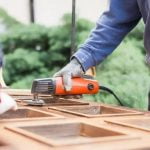Are you looking to revamp your woodwork with a fresh coat of paint? Look no further than spray painting woodwork. This versatile and efficient method of painting has gained popularity for its ease and professional finish. Whether you’re a DIY enthusiast or a professional painter, spray painting offers an array of benefits that traditional brush painting simply can’t match.
When it comes to achieving a flawless finish on woodwork, spray painting is often the go-to choice for many. From its ability to evenly cover intricate details to its time-saving advantages, there’s no denying the appeal of this method. In this article, we will explore the ins and outs of spray painting woodwork, from choosing the right type of spray paint to common mistakes to avoid.
Before you embark on your spray painting journey, it’s essential to familiarize yourself with the various aspects involved in the process. From selecting the right type of spray paint for your specific woodwork project to understanding proper ventilation techniques, our comprehensive guide will walk you through everything you need to know about achieving stunning results with spray painting.
Whether you’re a novice or seasoned pro, mastering the art of spray painting woodwork is sure to elevate the beauty and longevity of your wooden surfaces.
Benefits of Spray Painting vs Traditional Brush Painting
When it comes to painting woodwork, many people automatically reach for a brush and can of paint. However, spray painting woodwork offers a range of benefits that traditional brush painting may not be able to match. Here are some key advantages of using spray painting over the traditional method:
- Time-saving: Spray painting can cover a larger surface area in a shorter amount of time compared to brush painting. This is especially beneficial when working on bigger projects such as furniture or cabinetry.
- Smooth and even finish: Spray painting provides a more uniform and professional-looking finish, with no visible brush strokes. This makes it ideal for achieving a sleek, modern look on woodwork.
- Efficient use of paint: With spray painting, you can achieve better coverage with less paint compared to brush painting. This not only saves money on paint but also reduces the risk of drips and uneven application.
In addition to these benefits, spray painting also allows for greater precision and control, making it easier to reach difficult areas such as intricate detailing or hard-to-reach corners.
When choosing between spray painting and traditional brush painting for your woodwork project, consider these advantages and how they align with your specific needs and preferences. Whether you are refinishing furniture or adding a fresh coat of paint to your trim, spray painting may offer the efficient and professional results you desire.
Choosing the Right Type of Spray Paint for Woodwork
When it comes to choosing the right type of spray paint for woodwork, there are a few important factors to consider. The type of wood you are working with, the desired finish, and the level of protection needed will all play a role in selecting the best spray paint for your project. Here are some options to consider:
- Oil-based spray paint: This type of spray paint provides a durable and long-lasting finish, making it ideal for high-traffic areas such as doors and cabinets.
- Water-based spray paint: Water-based spray paints are environmentally friendly and have low odor, making them a great choice for indoor projects such as furniture and trim.
- Lacquer spray paint: Lacquer offers a high-gloss finish and dries quickly, making it suitable for projects that require a smooth and shiny appearance.
It’s important to also consider the specific requirements of your woodwork project when choosing the right type of spray paint. For example, if you are painting outdoor woodwork such as fences or deck railings, be sure to select a spray paint that is formulated for exterior use and can withstand exposure to the elements.
In addition to considering the type of spray paint, be mindful of the color options available. Many brands offer a wide range of colors and finishes, allowing you to find the perfect match for your woodwork project. By carefully selecting the right type of spray paint for your specific needs, you can ensure a professional-looking finish that will last for years to come. So take your time in choosing the best one at available hardwares or craft stores.
Preparing the Woodwork Surface for Spray Painting
When preparing woodwork for spray painting, it is important to ensure that the surface is clean, smooth, and free of any imperfections. This will ensure that the paint adheres properly and results in a professional-looking finish. The following sub-sections will cover some key steps to take when preparing woodwork for spray painting.
Cleaning the Surface
Before you begin to spray paint your woodwork, it is crucial to thoroughly clean the surface. Use a mild detergent or degreaser to remove any dirt, grease, or grime that may have built up over time. Once the surface is clean, rinse it with water and allow it to dry completely before proceeding with the next steps.
Sanding the Surface
After cleaning the woodwork, it is important to sand the surface to create a smooth and even texture. Use sandpaper with a fine grit to gently sand the entire surface of the woodwork. This will help to remove any rough spots or imperfections and will also provide a better surface for the paint to adhere to.
Applying Primer
Once the woodwork has been cleaned and sanded, it is recommended to apply a primer before spray painting. Primer helps to seal the surface of the wood and provides a base for the paint to adhere to. Be sure to choose a primer that is specifically designed for use on wood surfaces for best results.
By following these preparation steps, you can ensure that your woodwork is ready for spray painting. Taking these measures will result in a smooth and professional finish that will enhance the beauty of your woodwork while protecting it from wear and tear over time.
Techniques for Achieving a Smooth and Even Finish
When it comes to spray painting woodwork, achieving a smooth and even finish is essential for a professional-looking result. Here are some techniques to help you achieve the perfect finish on your woodwork.
Proper Distance and Angle
One of the most important techniques for achieving a smooth and even finish when spray painting woodwork is to maintain the proper distance and angle. Keep the spray can or gun about 8-12 inches away from the surface of the woodwork, and aim for a 45-degree angle. This will ensure that the paint is applied evenly and prevents drips or runs.
Even Overlapping Strokes
Another technique for achieving a flawless finish is to use even overlapping strokes when applying the paint. Start each stroke before reaching the edge of the woodwork, then continue all the way past it. This method ensures that each section of the woodwork receives an even coat of paint, without leaving any gaps or streaks.
Multiple Thin Coats
Instead of trying to cover the woodwork with one thick coat of paint, it’s best to apply multiple thin coats. This allows each layer to dry properly and reduces the risk of drips or uneven coverage. Wait for each coat to dry completely before applying the next one, and don’t rush the process.
By implementing these techniques, you can achieve a smooth and even finish when spray painting your woodwork, resulting in a professional-looking outcome that you can be proud of for years to come.
Common Mistakes to Avoid When Spray Painting Woodwork
When it comes to spray painting woodwork, there are several common mistakes that can easily be avoided with the right knowledge and preparation. One of the most important things to keep in mind is the importance of proper surface preparation.
Failing to properly clean, sand, and prime the woodwork can result in a finished product that is less than ideal. It’s crucial to take the necessary time and steps to ensure that the surface is smooth and free of any imperfections before beginning the spray painting process.
Another common mistake when spray painting woodwork is using the wrong type of spray paint. Not all spray paints are created equal, and choosing the wrong one for your specific project can lead to a subpar finish. It’s important to select a spray paint that is specifically formulated for use on wood surfaces, as this will ensure better adhesion and durability.
Proper technique is also essential when spray painting woodwork. One common mistake is holding the spray can too close or too far away from the surface, which can result in uneven coverage or drips. It’s important to follow the manufacturer’s recommendations for distance and speed when applying the paint. Additionally, not allowing each coat to fully dry before applying another one can lead to a streaky or patchy finish.
Lastly, ventilation is often overlooked but crucial when spray painting woodwork. Failing to properly ventilate your workspace can result in exposure to harmful fumes and poor air quality. Always work in a well-ventilated area or consider using a respirator mask to protect yourself from inhaling potentially toxic airborne particles during the spray painting process.
| Common Mistake | Preventive Measure |
|---|---|
| Improper surface preparation | Properly clean, sand, and prime the woodwork before spraying |
| Using wrong type of spray paint | Select a spray paint specifically formulated for use on wood surfaces |
| Improper technique (holding spray can too close/far away, not allowing coats to dry) | Follow manufacturer’s recommendations for distance and speed; allow each coat to fully dry before applying another one |
Tips for Properly Ventilating Your Workspace
Proper ventilation is essential when spray painting woodwork to ensure the safety of the painter and to achieve a professional finish. Without proper ventilation, fumes from the paint can build up and cause health issues, as well as creating an unpleasant working environment. Here are some tips for properly ventilating your workspace when spray painting woodwork.
One of the most important steps in proper ventilation is to work in a well-ventilated area. If possible, set up your workspace outdoors or in a well-ventilated garage with open doors and windows. This will allow for better airflow and will help to disperse any fumes from the spray paint.
If working indoors is necessary, be sure to use fans and open windows to create adequate airflow. Positioning fans to blow air out of the workspace can help to remove fumes and provide fresh air circulation. Additionally, setting up an exhaust fan near your work area can further assist in removing fumes and maintaining good air quality.
In addition to proper ventilation, wearing a respirator mask is also crucial for protecting yourself from inhaling harmful fumes or particles from spray painting woodwork. A mask specifically designed for use with spray paint will filter out harmful particles and ensure that you are breathing clean air while working. By following these tips for properly ventilating your workspace, you can maintain a safe and healthy environment while achieving professional results when spray painting woodwork.
Maintenance and Care for Spray Painted Woodwork
Once you have successfully completed your spray painting project on your woodwork, it’s important to consider the maintenance and care needed to keep your surfaces looking fresh and vibrant for years to come. Proper maintenance will ensure that your spray-painted woodwork maintains its beauty and protects it from wear and tear.
To begin with, it is important to regularly dust and clean your spray-painted woodwork. Use a soft cloth or duster to remove any dust or debris that may accumulate on the surface. This will prevent particles from scratching the finish and maintain the smooth appearance of the paint. Additionally, avoid using harsh chemical cleaners that can damage the paint. Instead, use a mild detergent diluted in water for cleaning.
In terms of care, it is essential to be mindful of how you handle and use the spray-painted woodwork. Avoid placing heavy or sharp objects directly onto the surface as this can cause scratches or dents. Similarly, be cautious when moving furniture or other items across spray-painted surfaces to prevent unnecessary damage.
Applying felt pads or coasters to the bottom of objects can help protect the surface from scratches and dings. Regular maintenance and careful handling will ensure that your spray-painted woodwork remains in top condition for years to come.
Properly maintaining and caring for your spray-painted woodwork extends beyond regular cleaning and precautions against damage. It’s also crucial to periodically inspect the surfaces for any signs of wear or damage.
Addressing these issues promptly by touching up areas where paint has worn away or become damaged will help preserve the overall appearance of your woodwork. By staying proactive in caring for your spray-painted wood surfaces, you can enjoy their beauty for many years to come while minimizing potential repair costs in the long run.
Conclusion
In conclusion, spray painting woodwork offers a versatile and beautiful alternative to traditional brush painting. The benefits of using spray paint for woodwork, such as achieving a smooth and even finish, are clear. Additionally, the ability to easily cover intricate details and hard-to-reach areas makes spray painting a popular choice for many DIY enthusiasts and professionals alike.
When choosing the right type of spray paint for woodwork, it’s essential to consider factors such as the type of wood, the desired finish, and any specific environmental considerations. Properly preparing the woodwork surface is crucial for ensuring a successful outcome, as is mastering the techniques for achieving an even coat. By taking care to avoid common mistakes and providing adequate ventilation in your workspace, you can create stunning results with spray painting woodwork.
Frequently Asked Questions
Can You Spray Paint Wood Trim?
Yes, you can spray paint wood trim. It’s important to prepare the surface properly by cleaning it thoroughly and possibly sanding it to ensure the paint adheres well. Using a primer specifically made for wood can also help.
Can You Spray Paint Over Wood Without Sanding?
It is possible to spray paint over wood without sanding, but it’s not recommended. Sanding helps the paint adhere better to the surface and creates a smoother finish. However, if you’re in a rush, using a quality bonding primer may help the paint adhere without sanding.
How Well Does Spray Paint Stay on Wood?
The longevity of spray paint on wood depends on various factors such as the type of wood, preparation of the surface, and environmental conditions. Generally, if the wood is properly prepared and primed before spraying, and if it’s protected from extreme weather or wear and tear, the spray paint should stay on quite well.

Hi everyone! I’m a woodworker and blogger, and this is my woodworking blog. In my blog, I share tips and tricks for woodworkers of all skill levels, as well as project ideas that you can try yourself.





